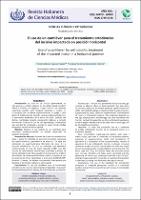| dc.contributor.author | Aguilar Salas, Víctor Marcel | |
| dc.contributor.author | Benavides Febres, Eleana Victoria | |
| dc.date.accessioned | 2021-12-01T20:27:16Z | |
| dc.date.available | 2021-12-01T20:27:16Z | |
| dc.date.issued | 2021 | |
| dc.identifier.citation | Revista Habanera de Ciencias Médicas. 2021; 20(3). | es_PE |
| dc.identifier.issn | 1729-519X | |
| dc.identifier.issn | 1729-519X | |
| dc.identifier.uri | https://hdl.handle.net/20.500.12959/2021 | |
| dc.description.abstract | Introduction:
The lack of a permanent incisor not only generates an adverse effect on facial aesthetics but also alters its function, especially the incisor guidance. Upper incisors can suffer mechanical blockage or change in their eruption due to a supernumerary tooth, a blow or another factor. The treatment of choice is orthodontic-surgical. The prognosis depends on the age, tooth position, morphology, size, root maturation and traction method. Knowing the use of an orthodontic appliance, which is easy to handle and can be used from an early age, will be of valuable contribution.
Objective:
To show the successful use of a cantilever to enable orthodontic traction of an impacted incisor in a horizontal position.
Case presentation:
Eight-year-old patient with class I malocclusion, specimen 2.1 retained in a horizontal position, presence of supernumerary tooth and persistence of specimen 6.1. Extraction of the supernumerary, release of specimen 2.1 and orthodontic traction is chosen. A buccal cantilever made of a 0.020” round steel arch with two circles at each end was used to provide elasticity and anchoring. The force used was 70 g. Six months after, the occlusion plane was reached. Brackets and tubes were cemented and the sequence of arches was continued until the 0.021”x0.025” steel arch was reached in 11 months. An optimal final position is obtained, favoring root formation and apical closure.
Conclusions:
The use of the cantilever for orthodontic treatment of impacted permanent incisors in a horizontal position proved to be successful as well as easy to manipulate and control. | es_PE |
| dc.description.abstract | Introducción:
La falta de un incisivo permanente no solo genera un efecto adverso en la estética facial, también altera la función, en especial, la guía incisiva. Los incisivos superiores pueden sufrir bloqueo mecánico o cambio en su erupción por un diente supernumerario, un golpe u otro factor. El tratamiento de elección es el quirúrgico-ortodóncico. El pronóstico dependerá de la edad, situación, posición del diente, morfología, tamaño, maduración radicular y método de tracción. Conocer el uso de una aparatología ortodóncica que sea fácil de manipular y pueda ser usada desde edades tempranas servirá de valioso aporte.
Objetivo:
Mostrar el uso exitoso de un cantiléver para traccionar ortodóncicamente un incisivo impactado en posición horizontal.
Presentación del caso:
Paciente de 8 años con maloclusión clase I, pieza 2.1 retenida en posición horizontal, presencia de supernumerario y persistencia de pieza 6.1. Se opta por extracción de supernumerario, liberación de pieza 2.1 y tracción ortodóncica. Se usó un cantiléver por vestibular confeccionado en arco de acero redondo 0.020” con dos círculos en cada extremo para brindar elasticidad y anclaje. La fuerza utilizada fue de 70 g, pasado 6 meses se alcanzó el plano de oclusión. Se cementaron brackets y tubos, se continuó con la secuencia de arcos, hasta llegar al arco acero 0.021”x0.025” durante 11 meses. Se obtiene una posición final óptima que favorece la formación radicular y cierre apical.
Conclusiones:
El uso del cantiléver para el tratamiento ortodóncico de incisivos permanentes impactados en posición horizontal demostró ser exitoso, fácil de manipular y controlar. | |
| dc.format | application/pdf | es_PE |
| dc.language.iso | spa | es_PE |
| dc.publisher | Universidad de Ciencias Médicas de la Habana | es_PE |
| dc.relation.uri | https://revhabanera.sld.cu/index.php/rhab/article/view/2882 | |
| dc.rights | info:eu-repo/semantics/openAccess | es_PE |
| dc.rights.uri | https://creativecommons.org/licenses/by/4.0/ | es_PE |
| dc.subject | Odontología | es_PE |
| dc.subject | Impacted teeth | |
| dc.subject | Orthodontic traction | |
| dc.subject | Tooth abnormalities | |
| dc.subject | Ectopic eruption of teeth | |
| dc.subject | Tooth movement techniques | |
| dc.subject | Orthodontic extrusion | |
| dc.title | El uso de un cantiléver para el tratamiento ortodóncico del incisivo impactado en posición horizontal | es_PE |
| dc.title.alternative | Use of a cantilever for orthodontic treatment of the impacted incisor in a horizontal position | |
| dc.type | info:eu-repo/semantics/article | es_PE |
| dc.subject.ocde | https://purl.org/pe-repo/ocde/ford#3.05.00 | es_PE |
| dc.publisher.country | PE | es_PE |






